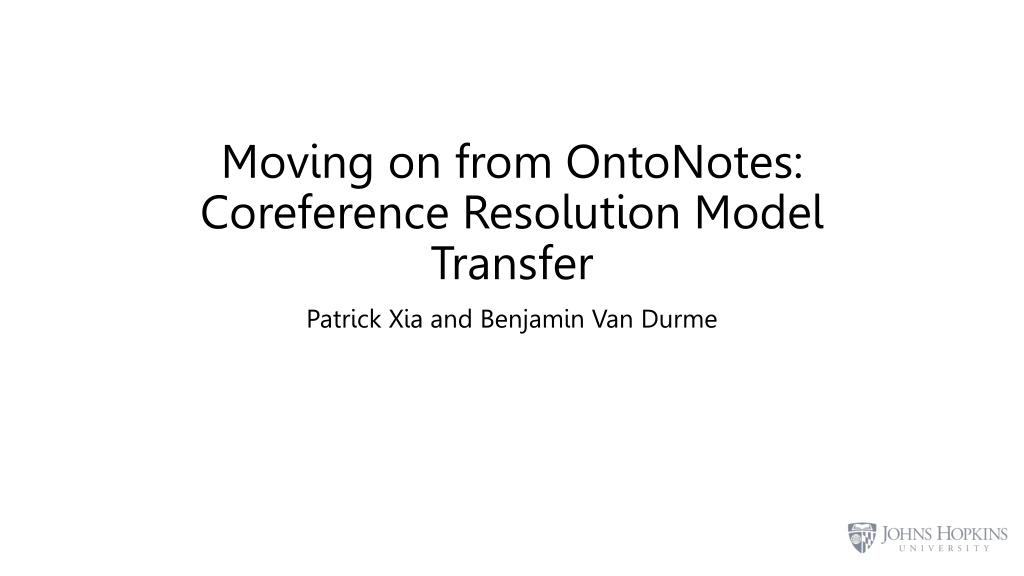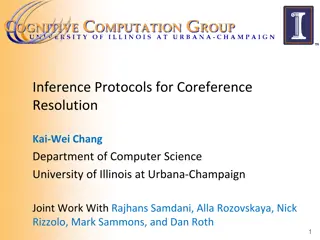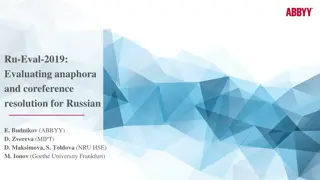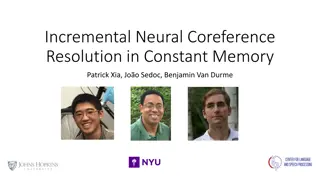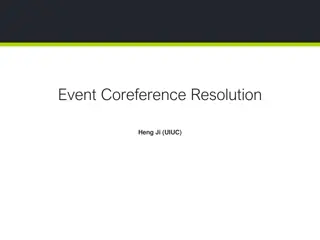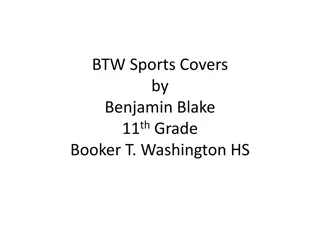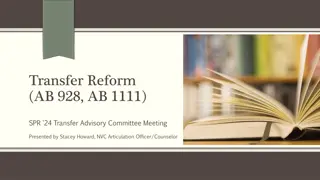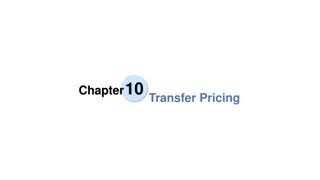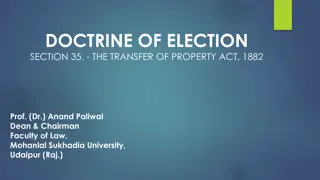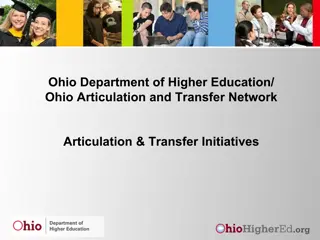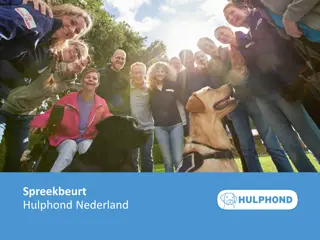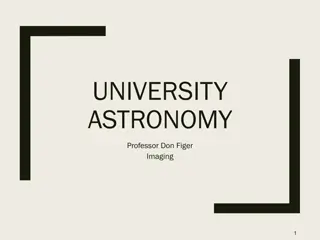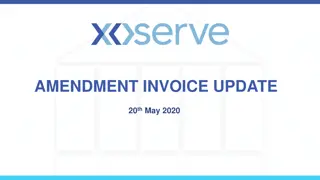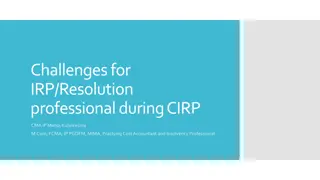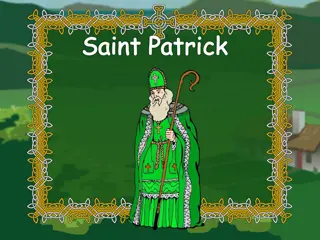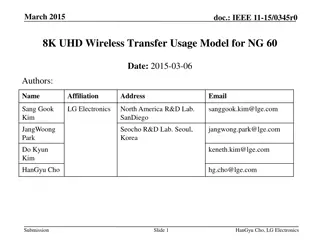Advancing Coreference Resolution: Transfer Model by Patrick Xia and Benjamin Van Durme
Coreference resolution models are crucial for identifying spans of text referring to the same entity. Explore the advancements in coreference resolution, including dataset differences, annotation types, and domain variations through the work of Patrick Xia and Benjamin Van Durme. Dive into the complexities of entity types, singletons, and more for enhanced understanding and application in natural language processing.
Download Presentation

Please find below an Image/Link to download the presentation.
The content on the website is provided AS IS for your information and personal use only. It may not be sold, licensed, or shared on other websites without obtaining consent from the author. Download presentation by click this link. If you encounter any issues during the download, it is possible that the publisher has removed the file from their server.
E N D
Presentation Transcript
Moving on from OntoNotes: Coreference Resolution Model Transfer Patrick Xia and Benjamin Van Durme
Background: Coreference Resolution Determine which spans of text refer to the same entity Hong Kong Wetland Park, which is currently under construction, is also one of the designated new projects of the Hong Kong government for advancing the tourism industry. antecedent This is a park intimately connected with nature, being built by the Hong Kong government for its people who live in a city of reinforced concrete. mention span
Background: Dataset Differences Annotation type: Singletons Entity types And Jo shook the blue army sock till the needles rattled like castanets, and her ball bounded across the room. Only coreferring mentions (OntoNotes)
Background: Dataset Differences Annotation type: Singletons Entity types And Jo shook theblue army sock till the needles rattled like castanets, and her ball bounded across the room. All mentions, including singletons (ARRAU)
Background: Dataset Differences Annotation type: Singletons Entity types And Jo shook the blue army sock till the needles rattled like castanets, and her ball bounded across the room. Only certain ACE entity types (LitBank)
Background: Dataset Differences Domain And Jo shook the blue army sock till the needles rattled like castanets, and her ball bounded across the room. Invisible Man is Ellison s best known work, most likely because it was the only novel he ever published during his lifetime Literature News (1) In general, The term employer means with respect to any calendar year, any person who - Legal
Background: Dataset Differences Domain And Jo shook the blue army sock till the needles rattled like castanets, and her ball bounded across the room. Invisible Man is Ellison s best known work, most likely because it was the only novel he ever published during his lifetime Literature News Language Cross-lingual transfer of coreference resolution
Research Questions Goal: reduce cost of creating a coref model on entirely new dataset 1. How effective is continued training for domain adaptation? 2. How to allocate annotated documents? 3. How much do source models forget? 4. Which encoder layers are important?
Methods: Source Models Memory-efficient coreference model Pretrained encoders only vs. fully-trained models clusters clusters clusters Linker Linker Linker VS. VS. embeddings embeddings embeddings Encoder Encoder Encoder SpanBERT-coref SpanBERT, Longformer, etc text text text Transfer model trained on source domain Pretrained encoder only Trained encoder only
Methods: Datasets Source Datasets: OntoNotes, PreCo Single domains: ARRAU (news), LitBank (books), SARA (legal), QBCoref (quiz questions) Multi-lingual: OntoNotes (en, zh, ar), SemEval (ca, es, it, nl)
Methods: Training Use standard train/dev splits Sample a subset of training set to simulate lower-data setting
Research Question: How effective is continued training for domain adaptation in coref? clusters clusters Linker Linker VS. embeddings embeddings Encoder Encoder text text Off-the-shelf trained encoder only Transfer model trained on source domain
RQ1: Continued training for domain adaptation Transfer models usually outperform randomly initialized models PreCo is as effective as OntoNotes PreCo is better with gold mention boundaries
Research Question: What s better? clusters clusters Linker Linker embeddings embeddings VS. Encoder Encoder text text Untrained large encoder Off-the-shelf trained small encoder
RQ1: Pretraining and model size Compare SpanBERT (L): large unspecialized model ( + SpanBERT-On (b): small specialized model ( Continued training of small (publicly available) encoders is effective with low # training docs ) + )
RQ1: Continued training also improves cross- lingual transfer Transfer model ( Improves SOTA performance on cross-lingual coreference + ) outperforms XLM-R ( + )
RQ2: How many documents should be in the dev set? Answer: Increasing dev set from 5 to 500 documents only gains 0.3 F1
RQ3: How much do the models forget? Largest drops: Annotation guideline changes Small(er) drops: Cross-domain Cross-lingual
RQ4: Do we need to train the full encoder? Answer: For transfer ( 12 layers is probably enough Not always true for other models + ) models, top 6-
Conclusions Continued training is effective for coreference resolution: Better overall performance Good initial (zero-shot) performance Cheaper training of new model PreCo is as good as OntoNotes OntoNotes requires a license For coreference, use annotated documents for training Fresh benchmarks on a wide set of datasets across domains and languages
Questions? Come to poster session Or email paxia@jhu.edu Code/pretrained models at: https://nlp.jhu.edu/coref-transfer/
